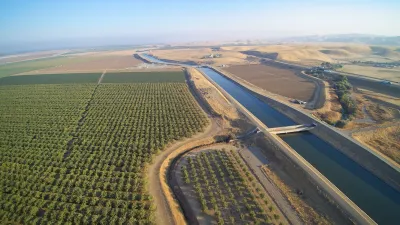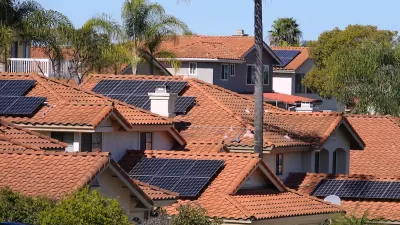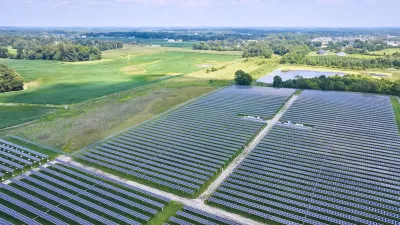Energy storage is acknowledged by many as a missing link of renewable energy, particularly by those quick to cite the intermittency of solar and wind power. A new solar thermal plant in Arizona stores energy in the form of heat for peak hour needs.
Matthew L. Wald writes about "a closely watched new solar project called Solana" in the Arizona desert built by Abengoa Solar. Unlike conventional solar plants that produce electricity for transmission to energy-hungry, metropolitan markets, Solana is also a cutting-edge, energy storage facility relying on "huge tanks of molten salt" to store heat from its "sprawling network of parabolic mirrors...in a three-square-mile patch of desert". It will sell its renewable energy, including the electricity it produces at night, to the utility, Arizona Public Service.
When the sun has set, the plant can draw heat back out of the molten salt to continue making steam and electricity...The emerging technology is one way that the utility industry is trying to make electricity from the sun available even when it is not shining, overcoming one of the major shortcomings of solar power.
If you thought that energy storage was solely the province of batteries, think again. Wald writes that "several (renewable power) plants have added banks of electric batteries. But battery storage is so expensive that these have been used mostly to smooth the output of the plant, not to store huge amounts overnight."
Batteries work great in electric cars because of the relatively high cost of gasoline. Solar has to compete with much cheaper power from coal and natural gas.
In neighboring California, another breakthrough of sorts is being watched, though this one is regulatory.
"In a bold move being closely watched by utilities, environmentalists and the clean technology industry, California on Thursday [Oct. 17] adopted the nation's first energy storage mandate", writes Dana Hull of the San Jose Mercury News.
(The) California Public Utilities Commission unanimously approved (a) groundbreaking proposal [PDF] that requires PG&E, Southern California Edison and San Diego Gas & Electric to expand their capacity to store electricity, including renewable energy generated from solar and wind.
"Storage really is the game changer in the electric industry. And while this new policy is not without risk, the potential rewards are enormous," said Commissioner Mike Florio.
Solar advocates will not be the only ones watching the Solana plant. With a $1.45 billion loan guarantee from the Department of Energy, skeptics will also also be tracking its progress.
FULL STORY: Arizona Utility Tries Storing Solar Energy for Use in the Dark

Study: Maui’s Plan to Convert Vacation Rentals to Long-Term Housing Could Cause Nearly $1 Billion Economic Loss
The plan would reduce visitor accommodation by 25,% resulting in 1,900 jobs lost.

North Texas Transit Leaders Tout Benefits of TOD for Growing Region
At a summit focused on transit-oriented development, policymakers discussed how North Texas’ expanded light rail system can serve as a tool for economic growth.

Why Should We Subsidize Public Transportation?
Many public transit agencies face financial stress due to rising costs, declining fare revenue, and declining subsidies. Transit advocates must provide a strong business case for increasing public transit funding.

How Community Science Connects People, Parks, and Biodiversity
Community science engages people of all backgrounds in documenting local biodiversity, strengthening connections to nature, and contributing to global efforts like the City Nature Challenge to build a more inclusive and resilient future.

Alabama: Trump Terminates Settlements for Black Communities Harmed By Raw Sewage
Trump deemed the landmark civil rights agreement “illegal DEI and environmental justice policy.”

Dear Tesla Driver: “It’s not You, It’s Him.”
Amidst a booming bumper sticker industry, one writer offers solace to those asking, “Does this car make me look fascist?”
Urban Design for Planners 1: Software Tools
This six-course series explores essential urban design concepts using open source software and equips planners with the tools they need to participate fully in the urban design process.
Planning for Universal Design
Learn the tools for implementing Universal Design in planning regulations.
City of Santa Clarita
Ascent Environmental
Institute for Housing and Urban Development Studies (IHS)
City of Grandview
Harvard GSD Executive Education
Toledo-Lucas County Plan Commissions
Salt Lake City
NYU Wagner Graduate School of Public Service





























